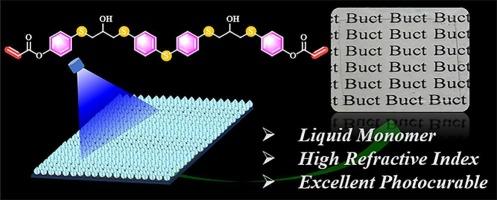Synthesis and characterization of liquid UV-curable-HRI acrylate monomers containing sulfur and aromatic groups
IF 6.3
2区 化学
Q1 POLYMER SCIENCE
引用次数: 0
Abstract
High-refractive-index (HRI) liquid monomers containing unsaturated acrylate double bonds possess advantages such as photocurability at room temperature and environmental friendliness. However, introducing acrylate groups often reduces the refractive index of monomers. Although small-molecule sulfur-containing structures have high refractive indices, their pungent odors restrict their applications. In this study, a series of sulfur-containing monomers have been successfully prepared through the optimized combination of sulfur elements, benzene rings, and acrylates. These monomers are in a liquid state, and the refractive index performance has reached an advanced level among photocurable monomers. Furthermore, the optical properties (refractive indices, transmittances), curing properties (double-bond conversion and rate of polymerization), and thermal stability (TGA) of the polymer films have been emphatically investigated. The polymer film has a refractive index of 1.648–1.672 at 589 nm, an Abbe number of 22.20–29.32, a transmittance of >90 % at 550–800 nm, a double-bond conversion of 70–92 %, and a maximum weight-loss rate (Tmax) temperature of 354–363 ℃, glass transition temperature (Tg) of 45.91 °C–58.45 °C. It exhibits excellent optical properties, curing properties, and thermal stability, opening up new possibilities for the applications of HRI materials.

含硫芳基液体紫外光固化hri丙烯酸酯单体的合成与表征
含不饱和丙烯酸酯双键的高折射率(HRI)液体单体具有室温光固化和环境友好等优点。然而,引入丙烯酸基团往往会降低单体的折射率。虽然小分子含硫结构具有高折射率,但其刺鼻的气味限制了其应用。本研究通过硫元素、苯环和丙烯酸酯的优化组合,成功制备了一系列含硫单体。这些单体呈液态,折射率性能在光固化单体中达到了先进水平。此外,还重点研究了聚合物薄膜的光学性能(折射率、透射率)、固化性能(双键转化和聚合速率)和热稳定性(TGA)。该聚合物薄膜在589 nm处折射率为1.648 ~ 1.672,阿贝数为22.20 ~ 29.32,550 ~ 800 nm处透光率为>; 90%,双键转化率为70 ~ 92%,最大失重率(Tmax)温度为354 ~ 363℃,玻璃化转变温度(Tg)为45.91℃~ 58.45℃。它具有优异的光学性能、固化性能和热稳定性,为HRI材料的应用开辟了新的可能性。
本文章由计算机程序翻译,如有差异,请以英文原文为准。
求助全文
约1分钟内获得全文
求助全文
来源期刊

European Polymer Journal
化学-高分子科学
CiteScore
9.90
自引率
10.00%
发文量
691
审稿时长
23 days
期刊介绍:
European Polymer Journal is dedicated to publishing work on fundamental and applied polymer chemistry and macromolecular materials. The journal covers all aspects of polymer synthesis, including polymerization mechanisms and chemical functional transformations, with a focus on novel polymers and the relationships between molecular structure and polymer properties. In addition, we welcome submissions on bio-based or renewable polymers, stimuli-responsive systems and polymer bio-hybrids. European Polymer Journal also publishes research on the biomedical application of polymers, including drug delivery and regenerative medicine. The main scope is covered but not limited to the following core research areas:
Polymer synthesis and functionalization
• Novel synthetic routes for polymerization, functional modification, controlled/living polymerization and precision polymers.
Stimuli-responsive polymers
• Including shape memory and self-healing polymers.
Supramolecular polymers and self-assembly
• Molecular recognition and higher order polymer structures.
Renewable and sustainable polymers
• Bio-based, biodegradable and anti-microbial polymers and polymeric bio-nanocomposites.
Polymers at interfaces and surfaces
• Chemistry and engineering of surfaces with biological relevance, including patterning, antifouling polymers and polymers for membrane applications.
Biomedical applications and nanomedicine
• Polymers for regenerative medicine, drug delivery molecular release and gene therapy
The scope of European Polymer Journal no longer includes Polymer Physics.
 求助内容:
求助内容: 应助结果提醒方式:
应助结果提醒方式:


